Thursday, January 31st, 2013
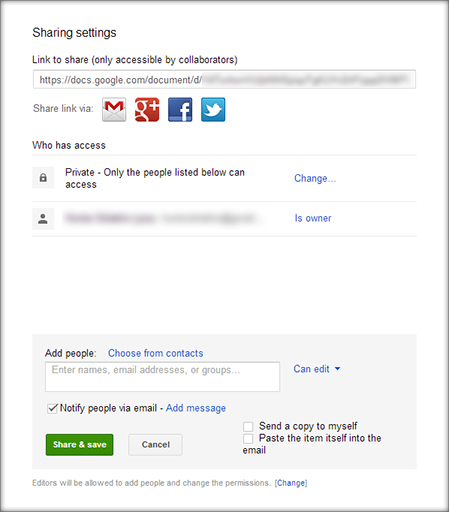
Google docs makes shared viewing and editing of documents easy and neat.
To begin sharing a document, click the blue Share button in the top right corner. You will immediately be given a share link, but there are a few important options to consider before you hand it out.
In the Who has access section you can change the privacy settings for the document. By default it is set to private; you must give explicit permission to anyone you want to access the document by entering their email or some other contact detail, such as their name. You can also set the privacy to public on the web and anyone with the link. The only difference between these options is that your document will be viewable through Google searches and other public indexes using the public option, while viewers will have to receive a specific link to view the document using the latter option.
It is also important to set exactly how much access others have to your document. When you add a contact to your share list, they have editing capabilities by default. To change this, click can edit while adding the contact and select their preferred capabilities. You can allow them to simply view, comment, or have full editing power. But you’re not quite done yet. If you click the [change] button at the very bottom of the share window, you can decide whether editors can give access too. By default, editors are allowed to do anything that the document’s owner can except to delete the document. If you want to keep for yourself the right to decide who can view the document, make sure to set this to only the owner can change the permissions.
Once you are done configuring your share settings, simply click Done. Everyone you added to the share list will receive an email notifying them of their ability to view the document.
Helen Bradley
Labels: editor, google docs, link, owner, permissions, privacy, public, share, share list
Categories:hunter, office
posted by Hunter Delattre @ 9:00 amNo Comments links to this post
Tuesday, January 29th, 2013

Image credit Pawel 231 sxc.hu
Are you searching Windows 8 for its DVD player and DVD burner? Well stop wasting time – they aren’t there
Yep, that’s right. Windows 8 ships without a built in DVD burner and there is no installed DVD player software either. If you don’t have a DVD drive and I guess Microsoft thinks they are so “yesterday’s technology” you’re OK. But I still have a DVD drive and so do millions of others. The worst part of this is that Microsoft doesn’t warn you there’s no DVD burner or player – you have to work that out yourself.
So, all across the world, every day, thousands of man and woman hours are being wasted looking for something which, let’s face it, should be there, but isn’t. Gee, thanks a bunch for that Microsoft!
So, here’s what to do if you have a brand new Windows 8 computer or if you’ve upgraded to Windows 8 and you have a DVD drive.
1 Stop looking. There is no DVD burner and no built in DVD player. If you have either of these on your Win 8 machine it didn’t come with Windows 8 – your PC manufacturer (or tech savvy daughter or son), put it there.
2 Get the software. The best solution if you’re using Windows 8 Pro, although I hate to suggest it is to shell out $9.99 to Microsoft for the Media Center software. This isn’t included in Windows 8 but can be downloaded and installed. You use this to play DVDs on your PC. To get it, launch Windows 8, tap Windows + Q (Search) and in the box type Add Features and tap Settings. Tap Add features to Windows 8 and then click I want to buy a product key online and you can go ahead and buy Media Center.
Now, there is one caveat. If this option doesn’t appear (and it may not because Microsoft left it out of some versions of Windows 8 such as the UK version and other users have reported it as disappearing once it is used the first time – yeah! well done Microsoft!) you can try this. Click Windows + Q, type System and tap Settings and click System. Now click View Details in Windows Activation. Once there you may find a link to add features or click Buy Windows for another computer to go to the website to buy Media Center – search for it when you get there. Until Jan 31, 2013 if you use Windows Pro you can get a licence code that lets you download it free of charge, otherwise it costs $9.99 if you’re using Windows Pro – it will cost a huge chunk of change if you’re using the Home version though.
3 If this all sounds like too much trouble, download the free opensource VLC Media player which is compatible with Windows 8 from http://sourceforge.net/projects/vlc/ all the open source folk love it.
4 To burn DVDs you need a DVD burner and the Windows DVD program no longer exists in Windows 8, so, you’ll need some burning software. There are plenty of programs around from folks like Nero but they can be pretty costly and not all are compatible with Windows 8 . If you just need a very simple burner, try Ashampoo Burning Studio Free 2013 – the Ashampoo products are great and the company does a good line in simple to use CD and DVD burners that don’t need a degree in computing to operate. Get the free version from Softpedia here or from CNET here.
Bonus Tip – where to find a list of features missing from Windows 8
If you’re searching for features that you think should be in Windows 8 but you can’t find, check this Wikipedia article: Features removed from Windows 8 for a handy list of what is missing from Windows 8 – it might save you some wasted time.
Helen Bradley
Labels: add features to Windows 8 missing, dvd burner, dvd player, Microsoft, Win8, Windows 8, windows 8 media center
Categories:office, Uncategorized
posted by Helen Bradley @ 11:29 am2 Comments links to this post
Saturday, January 26th, 2013
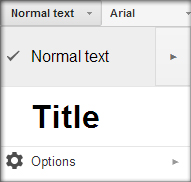
You can easily change your default font settings in Google docs using styles.
To change your default text style for all future documents, you must first update the Normal text style. Highlight some text with the formatting you want to adopt as your default, open the styles dropdown menu, and click the arrow next to Normal text. In the resulting menu, select Update ‘Normal Text’ to match. This redefines the Normal text style to match the selected text. To make this change permanent, open up the style menu again and select Options > Save as my default styles. This means that the new Normal text style will be used for all future documents. In this way you can set, for example, 12-point Times New Roman as your default font for Google docs.
If you ever want to undo all style changes, return to the options menu and select Reset styles. This will reset them to the original default settings, but only within that document, so you must then choose Save as my default styles again if you wish to make the reset permanent.
Helen Bradley
Labels: default, font, formatting, google docs, style, styles, text
Categories:hunter, office
posted by Hunter Delattre @ 9:00 am2 Comments links to this post
Saturday, January 19th, 2013
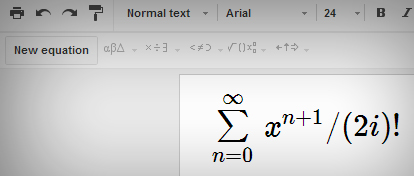
It can often be difficult to represent more complex mathematical equations in a word processor. Google Docs makes it easy with the equation toolbar. To activate it, select View > Show equation toolbar.
To create your equation, simply click New equation and begin filling it in with operations from the insert function dropdown menus. Even if you require none of the special operations provided, the New equation feature will also neatly format simple equations that can be entered using the keyboard.
Helen Bradley
Labels: create, document, equation, google docs, insert, math
Categories:hunter, office
posted by Hunter Delattre @ 8:00 amNo Comments links to this post
Monday, January 14th, 2013
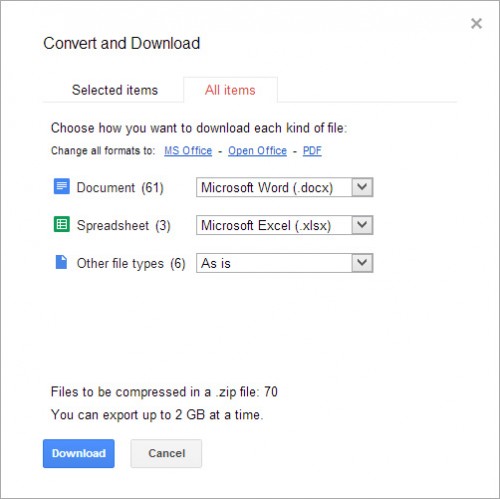
You can quickly save all of your Google documents to your hard drive by Right Clicking on any one of your documents and selecting Download…. In the popup window select the All Items tab along the top. Google Docs will display the quantity of each document type and allow you to select the format you want to download each type in. Click Download and all of your documents will downloaded as a zip file.
Google compresses the files into a zip file for you, which can take some time. If you have many documents, you can have Google email you the download link once it finishes the zipping process so that you don’t have to sit and wait.
Helen Bradley
Labels: all, download, export, files, google docs, quick
Categories:hunter, office
posted by Hunter Delattre @ 8:00 am2 Comments links to this post
Thursday, January 10th, 2013
 Photo Credit: Kriss Szkurlatowski
Photo Credit: Kriss Szkurlatowski
Creating multiple new folders in windows can be a pain, since it forces you to click through multiple context windows every time. It can, however, be bypassed with a nifty set of keyboard commands that navigate those windows for you.
While in the Windows Explorer view, simply hold Alt and press F+W+F. This opens the File menu, selects New, and chooses Folder almost instantly. This is extremely useful because it allows you to create and rename multiple new folders without taking your hands off of the keyboard.
You can use these commands to open other menus as well. While holding Alt you will notice certain letters of menu selections become underlined. Pressing these letters on your keyboard will select that menu option. For example, Holding Alt and pressing F+W+S will create a new shortcut. This functionality extends to Microsoft Office as well. The next time you’re in Word, press Alt and see what you can start controlling with a few key strokes.
Helen Bradley
Labels: explorer, folder, keyboard, Microsoft, new, Office, shortcut, windows
Categories:hunter, office
posted by Hunter Delattre @ 9:00 amNo Comments links to this post
Friday, December 28th, 2012
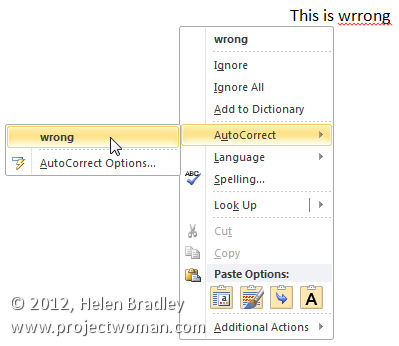
Ok, I really really like the new Office 2013 suite. But there are always some things you don’t like and this one is a biggie. It is in Word 2013 and it’s not like I don’t like an added feature it is that Microsoft removed a feature I love and that I use every day.
What is gone is the right click auto correct from the shortcut menu. In earlier versions of Word when you saw a spelling mistake indicated by a wiggly red line under a word you could right click and choose AutoCorrect and then select the correct spelling of the word. Word would then add this misspelling and the correction to its AutoCorrect list so that, in future, whenever you typed the word incorrectly Word would automatically fix it for you.
This right click feature has been removed from Word 2013 – Why? Who knows? It has to go down as one of the stupidest things that Microsoft has done – really there is no reasonable explanation for this feature being removed. It is totally frustrating not to have this feature on the right click menu.
If you need to use this feature you’ll need to make your own AutoCorrect list entry by choosing File > Options > Proofing > AutoCorrect options and enter the misspelling in the Replace list and the correct spelling in the With list. This is extremely inconvenient but it’s how Word 2013 now works – go figure! Thanks for the AutoCorrect love Microsoft – Not..
Helen Bradley
Labels: AutoCorrect, Microsoft Office 2013, missing, removed feature, spelling correction, Word 2013
Categories:office
posted by Helen Bradley @ 9:01 amNo Comments links to this post
Monday, December 24th, 2012
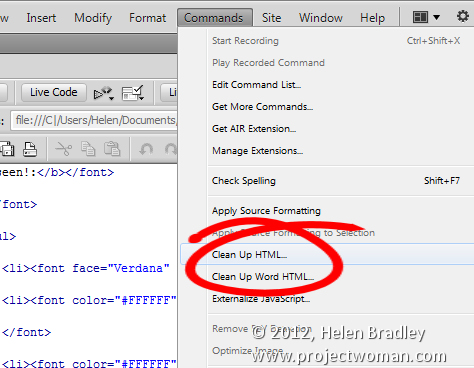
Ok, confession time. Some of my websites still use FrontPage 2003 for the code. It isn’t pretty but it is one of those things that work and, if it isn’t broken, I don’t generally fix it.
However today I headed over to helenbradley.com to give it a once over. The problem was that I had seen in my stats that the PR company for a major software provider had trawled my site recently and when I looked at what they checked out I realized how out of date it all was. So it was time for an update. Instead of FrontPage I grabbed all the existing HTML and opened the pages in Dreamweaver and let out one very big groan. They were full of font tags – nearly every piece of text had a font face, size and color associated with it.
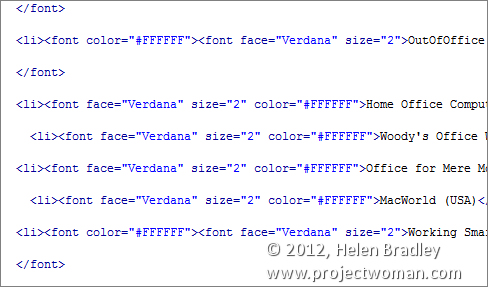
The obvious solution was to make a site wide .css file and put all the formatting in there. Well that is dead easy but what about all the garbage in my code – how to get rid of that? The last thing I wanted to do was to select and delete it all one code at a time.
Turns out that Adobe had already thought of that and there is a command you can select to strip code. I chose Commands > Clean Up HTML and then selected the code to clean up.
As my code had too many Font codes in it I chose to specifically remove all of them too.
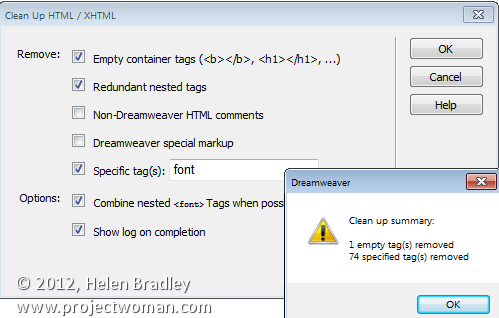
One click and all the mess was gone leaving me with the content stripped of its formatting.
I created some CSS styles for the text formats to use in the external .css file, attached it to each page, applied the styles to the text and it was all fixed, tested and up.
Now that site is officially FrontPage 2003 free and working just fine in Dreamweaver. I have one more site to bring across and then I can say farewell to FrontPage!
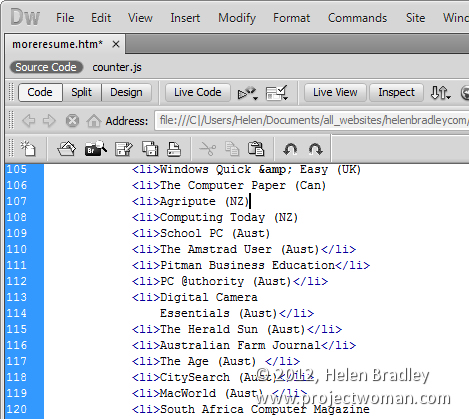
Helen Bradley
Labels: .html, clean up code, cs5, cs6, Dreamweaver, frontpage 2003, remove tags, strip code, strip formatting
Categories:Dreamweaver, office
posted by Helen Bradley @ 9:25 amNo Comments links to this post
Tuesday, December 18th, 2012
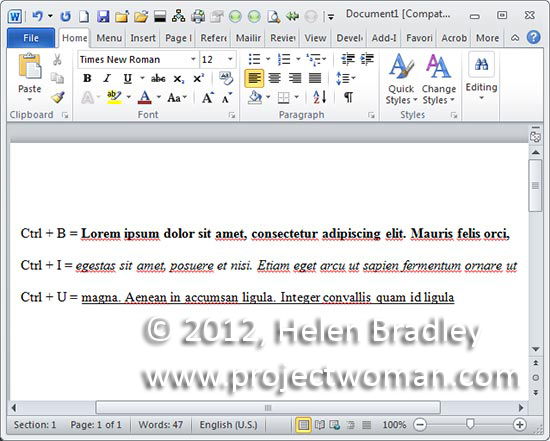
When you want some text to stand out by being bolded you can press Ctrl + B and then type the text. To turn bolding off, press Ctrl + B again. This also works to bold already typed text – select the text and press Ctrl + B to bold it. The keyboard shortcut Ctrl + I can be used to italicize text and use Ctrl + U to underline it.
Helen Bradley
Labels: bold, how to, italics, Microsoft Office, tip, trevor office, trevor payne, underline, Word
Categories:office, trevor tip
posted by Trevor Payne @ 8:00 amNo Comments links to this post
Friday, December 14th, 2012

Google Docs has a handy research tool built right into the page that utilizes Google’s massive information database. It can provide a useful catalogue of information on almost any topic.
To open the Research module, go to Tools > Research. Alternatively, you can highlight some text from your document, right click, and select Research ‘[your text]’ from the context window. This will automatically research the highlighted text.
If your topic has any specially indexed information, it will be shown in a summary at the top of your results. It may also show relevant images and published papers on the topic. When Google has exhausted all the information it can find itself, it will simply display a list of search results. Yet these results also contain a useful set of tools unique to the Research module: Preview, Insert Link, and Cite.
Preview provides a quick look at the web page to help you determine if it will actually be useful to you. Insert Link automatically creates a link to the web page in your document. If you used highlighted text to open the Research module, it will turn that text into your link. Cite creates a neat citation for that web page, which is in MLA format by default.
If we take a look at the main page of the Research module again, we’ll find search filters for different needs.

Everything provides the results we initially saw, with as much information as Google could provide. Images narrows your search to just that, a sidebar of topical images which can be easily dragged and dropped into your document. Scholar provides a list of published research papers for your topic, although it does not provide direct links to those papers. These can be easily cited the same way web links can.
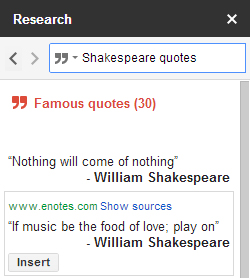
Quotes provides a list of relevant quotes which can also be inserted into your paper. Google also highlights the most famous quotes for you. Dictionary provides a fast and light way to check words’ definitions. Finally, Personal simply shows any files you already have on your Google account that fit the query.
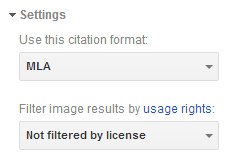
You can also make two important changes in the Settings dropdown menu. The citation format can be swapped between MLA, APA, and Chicago, depending on your need. If you’re using your document for commercial purposes, or if you simply hate unlicensed imagery, you can filter your image search results to show only those which grant a commercial licence.
Overall, the Research module is an excellent tool to help you quickly collect information and content for your document and is worth checking out.
Helen Bradley
Labels: apa, chicago, citation, dictionary, google docs, images, mla, quotes, research, tool
Categories:hunter, office
posted by Helen Bradley @ 9:00 amNo Comments links to this post


















